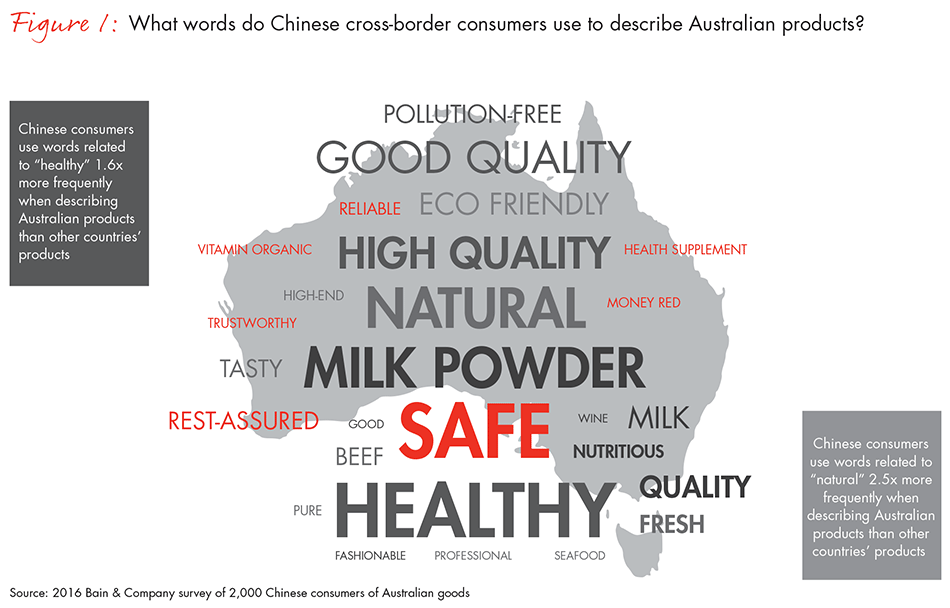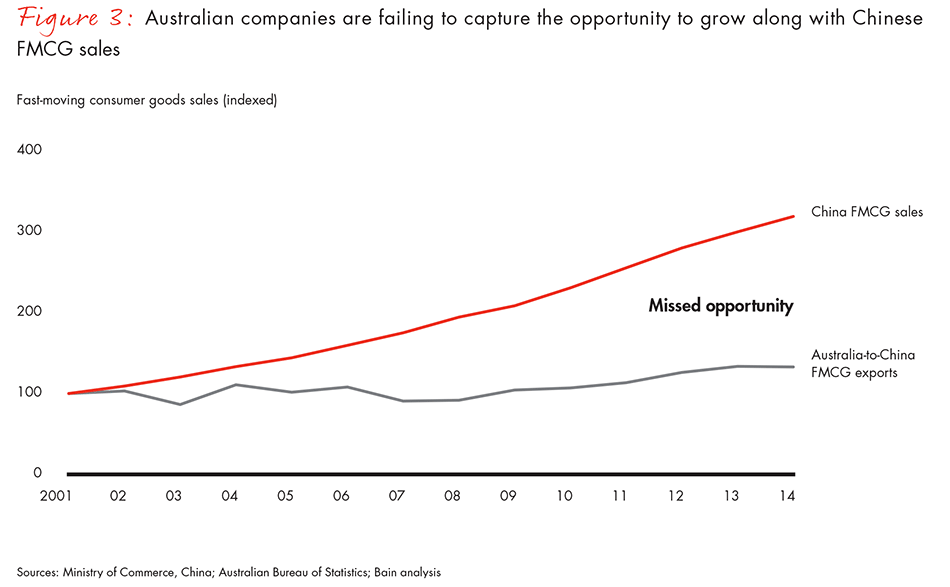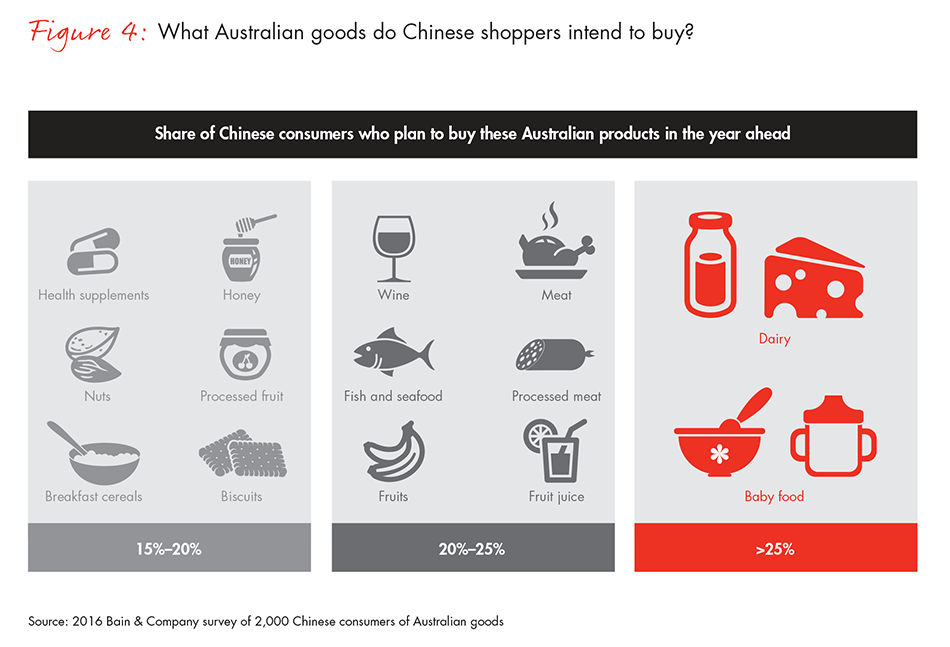Brief

When the Chinese think of Australia, it isn’t only kangaroos and koalas that come to mind. They also envision clean air, green grass, pristine beaches, nutritious food and a healthy population. Indeed, Australia is one of the world’s healthiest countries, according to the United Nations, the World Bank and the World Health Organization.
Each year, a rising number of Chinese tourists are coming to see Australia for themselves—tourism from China is growing by 20% annually (see below, “Welcome to Australia”). And those who stay home are buying more and more Australian products. Concerned about the safety of food and other goods produced in their own nation, they’ve generated massive demand—and a thriving market—for Australian products sold on China’s booming e-commerce platforms, in retail shops and through networks of daigou, the term for the tens of thousands of mom-and-pop exporters who ship goods to families and friends in China, or to online sellers, for resale to health-conscious consumers.
When Bain & Company recently interviewed 2,000 cross-border shoppers in China, they were 1.6 times more likely to associate Australia with health and nutrition than the US, Germany, Japan and South Korea, and 2.5 times more likely to associate Australia with words related to “natural” (see Figure 1). This opens up the potential for brand positioning that is clearly differentiated from other cross-border leaders such as Germany, where safety is more related to process discipline than the authenticity of inputs. But it’s a quickly evolving market, with channels shifting and regulatory issues hovering in the background.
Over the past two years, some brands have achieved major success by selling to China. Among the winners are Swisse Wellness, whose revenues soared from around A$390 million to A$690 million over the 12 months ending in June 2016, based largely on Chinese sales. Revenue growth for the vitamins and supplements company “slowed” to 60% in a recent quarter, but with a nearly fivefold increase in profits. Swisse competitor Blackmores, also benefitting from sales to the Chinese, enjoyed 52% sales growth in the same period, driving bottom-line growth of 115%. By serving Chinese demand for safe and healthy infant formula brands, Bellamy’s, A2 Milk and Aptamil have largely underpinned the market for Australian formula, with retail sales more than doubling in just 18 months, despite a sustained decline in birth rates and an increase in breast-feeding rates in Australia.

China’s retail market is second only to the US. Following 14% compounded annual growth over the past decade, the country’s slowing economy led to 3.5% growth in sales of fast-moving consumer goods (FMCG) in 2015, a five-year low. But even with that deceleration, each year’s growth in Chinese FMCG sales is almost the size of Australia’s entire FMCG market. Moreover, the rise in sales of product categories associated with health and nutrition, as well as imported goods, has been steady, as Chinese consumers who can afford to continue to trade up (see Figures 2 and 3).


Imported products in premiumizing categories—those with average prices that rose faster than inflation—have either higher growth or higher share than other categories. A reflection of China’s rising middle class, this strong performance is especially true for packaged food, beverage and baby-related categories, according to research conducted by Bain & Company and Kantar Worldpanel (see the report Dealing with Two-Speed China).
Indeed, China is a big, fast-moving market with a huge and expanding middle class and rapidly evolving channels. It represents a major business opportunity for makers of everything from yogurt to honey, fruit juice to nuts, milk powder to wine—anything that Chinese consumers perceive as being healthier and more natural if it comes from Australia (see below, “What Chinese Consumers Want from Australia”).
Premium price, premium profits
The Australian Bureau of Agricultural and Resource Economics and Sciences predicts China will account for 43% of global growth in agricultural demand by 2050. This trend is already seen in a range of Australian exports to China. For example, China is Australia’s second-largest market for dairy exports. In fiscal 2015, Australia sold A$269 million of wine to China, which now is the third-largest market for Australian wine. As the number of middle-class households skyrockets, and with it demand for high-end products, China’s wine-import market has doubled in size to A$2.1 billion in just five years. And this is only the beginning.
Chinese consumers are willing to pay more for overseas goods. In fact, some Australian products can more than double their prices, with much of the incremental profit flowing through to the supplier bottom line. Profitability in China, along with other developing markets in Asia, matches and sometimes exceeds global levels. Capilano and Comvita Honey enjoyed nearly 70% profit growth in a recent 12-month period, from increases in both volume and prices—Capilano honey sells for up to A$350 for a 500-gram jar in China.
In addition to the extreme winners, like Swisse, Bellamy’s, Treasury Wine Estates and Comvita, some more traditional brands are starting to gain traction in China. The ranks include iconic Australian brands Weet-Bix, Tim Tam, Nobby’s and Vegemite; “clean and green” brands Carman’s Muesli and TOM Organic; and functional brands Nu-Lax, Gumption and Banana Boat. But while these Australian brands are taking advantage of this opportunity, many others are missing out. So why can some brands ride this huge wave created from Australia’s competitive advantage as a natural, safe and clean food environment, while others haven’t been able to get started?
The answer lies in a consumer goods company’s ability to establish and market a brand that is truly Australian, generate demand for that brand in China, build a system for making it readily available to Chinese consumers and developing the right capabilities for scaling to growth. Digital plays a major role in achieving a brand’s ambitions to reach, convert and serve China’s consumers. For example, the best companies use social media to get the word out, and they rely on huge amounts of customer data to target marketing efforts. Other digital capabilities allow them to launch products and test quickly, then easily expand to a broader population, while the evolving e-commerce infrastructure enables seamless payment and speedy delivery, even for niche products sent to remote locations.
Based on our experience with clients succeeding in China, there are four critical steps for Australian brands hoping to make it in China. We’ll look at them one-by-one.
Step 1: Make the brand a credible Australian brand
When selling to China, it’s crucial to have a brand that has first achieved consumer credibility in Australia. Without this, “Brand Australia” just doesn’t work. There have been a number of less successful attempts to launch an adjacent product, even from brands whose core product offering resonates strongly in China. But unless a product has made it first in Australia, it will be viewed as a “made for China” knockoff. Chinese consumers look at what Australian consumers choose as reference points for quality.
Step 2: Create consumer pull in China
You need to be thoughtful about how you seek to win the hearts and minds of Chinese consumers. On a fundamental level, that starts by clearly understanding your consumers, including what they want and how they shop. Consumer-to-consumer (C2C) platforms can represent up to 60% of online category sales. Depending on the category, the daigou (“suitcase” entrepreneurs) account for as much as 20% of C2C sales—and can be a very useful contributor to sales and brand building, especially when establishing and growing a China business. Success with the daigou usually requires “seeding” the product within Chinese-centric communities in Australia. One way to achieve this is by targeting the top 20 postcodes with Chinese nationals in Australia and arming them with the right marketing collateral to build brand awareness.
Instead of tailoring collateral to Chinese consumers, it’s often better to use existing collateral from other markets, reinforcing in consumers’ minds that the product wasn’t simply made for China. Winning companies also create demand by promoting their products wisely on online forums and blogs in Australia and China, offering in-store sampling in China, and finding the right online ambassadors. Tennis champion Li Na successfully promotes Blackmores products online in China, for example.
Step 3: Create the push with the right channels and distributors
Winning with China’s consumers means guiding your product through the evolving e-commerce and brick-and-mortar channels, while negotiating a complex set of traditional distributorship realities.
Let’s start with e-commerce. China now ranks as the world leader in e-commerce, which accounts for 12% of all Chinese retail sales and is set to nearly triple in the next five years, with mobile sales representing the fastest-growing segment. Cross-border trade will expand even faster, with food, baby and personal-care products accounting for much of this growth. And there will be even more opportunity in the future, as China’s smaller cities and rural areas, now relatively underpenetrated in e-commerce, find new logistics solutions that help them overcome last-mile challenges. Through e-commerce, even niche Australian brands with less than 1% of the domestic market can reach consumers at a profit, challenging the very paradigm of scale economics.
The most successful Australian brands will be those that carefully choreograph their moves. They’ll build both awareness and penetration in C2C platforms, through Alibaba’s Taobao, and increasingly through WeChat, the Twitter equivalent that offers a wallet function and maintains a staggering 93% penetration in Tier-1 cities. They’ll advance to business-to-consumer (B2C) platforms such as JD.com, VIP.com, Koala and the top Tmall resellers, with the goal of selling directly on Tmall Global and JD.
One method for broadening reach on C2C platforms: creating the right economics for the daigou. A proven option is promotional activities to ensure the product is at least as attractive as the competition. When A2 Milk began offering 10% to 20% promotions on its infant milk formula, it saw a sixfold increase in sales to daigou, which reaped higher margins when they resold the products online. For any brand, a network of daigou can blossom to tens of thousands of points of distribution on the top C2C sites. And the opportunities for product categories are increasing as daigou networks establish cold chain capabilities, enabling the sale of fresh milk, yogurt and fresh fruit in as few as two days.
On B2C platforms, some online sellers are making big strides with innovative targeted marketing. For example, Alibaba’s unified ID program enables brands to identify consumers based on their location, demographics, interests, social activity and purchase behavior.
Success on B2C platforms will position a consumer goods company to move into brick-and-mortar retail with limited additional investment. One way is by using its established brand equity in China to get listed by a major retailer. Of course, understanding the retail landscape is a requisite for success—not only given the geographic diversity, but also the variations in city-level infrastructure. The path to purchase in a Tier-1 or Tier-2 city is very different from that in a smaller city today, for instance. Another way to move into the physical world is by opening brick-and-mortar stores to capture the retailer, as well as the manufacturing margin. In some categories, companies are investing to develop their offline-to-offline (O2O) business, with physical stores that include virtual shelves directing shoppers to their expanding range of e-commerce platforms.
Meanwhile, growing in China means becoming aware of the rapidly changing distributorship world. As growth in the country’s general economy slows, distributors are under mounting financial pressure. Many are driven out of business or decide to switch to more attractive ventures, outside of FMCG brand distribution. As a result, some brands are losing distribution points in China, and they need to find cost-effective ways to recapture those points. Winning requires building the necessary capabilities in China and finding the right partners there.
Step 4: Develop the right capabilities
To succeed in China, Australian companies must tailor their approach and offer on a city-tier and regional basis, maintaining an on-the-ground presence to understand the culture and manage a variety of relationships.
There are a number of tactical considerations. Companies have to adapt the brand messaging for Chinese consumers at the local level, for example, and develop pricing and promotions capabilities that limit channel conflict. And again, because distribution is a critical factor—and a moving target—success in China requires strong relationships with the key distribution partners, including e-commerce, distributors, and retailer account management once a certain scale is achieved.
This doesn’t mean a significant investment upfront. It will be required over time. But in the early stages of growth, companies need to remain agile and make measured bets. We are witnessing significant first-mover advantage for pioneers. But instead of betting the house, it’s better to use a China strategy as an opportunity to systematically test and learn.
Indeed, China is a place for hedging bets and recognizing that there isn’t a single path to success. Treasury Wine Estates and others have won by selling their products in China’s brick-and-mortar stores before transitioning to online sales. However, the rise of e-commerce and its supporting infrastructure has made the digital marketplace a great leveler for consumer goods companies competing in China. Undoubtedly, more brands are likely to prosper by focusing the bulk of their investment in the online world.
Keeping an Eye on Regulations
As with any promising market, there are risks to consider and manage. For many FMCG companies entering China, one of the biggest risks involves regulations. The country’s moves to limit or impose taxes on imports have created an environment of uncertainty. But the regulatory changes so far have been focused on protecting Chinese consumers, rather than protectionist measures aimed at limiting foreign goods.
What’s the best strategy to prepare for regulations? Don’t make China your only bet, and don’t overemphasize any one channel; maintain strategies for both offline and online. Also, be flexible to react to changes and always be prepared, continually scouting for signs of changing regulations. The best players are rarely surprised. They already have an alternative plan in place.
For consumer goods companies seeking profitable growth, now is the time to lay out a strategy for winning in China. But it takes thoughtful attention to four critical steps: making the brand credible in Australia first, creating demand with China’s consumers, choreographing a channel and distributor strategy, and building the right capabilities to support growth. That’s what it takes to make it as an Australian brand in China.
What Chinese Consumers Want from Australia
To understand the dimensions of the latent market for Australian goods, Bain & Company recently surveyed 2,000 cross-border shoppers in mainland China. Up to 20% of our survey respondents said they intended to buy health supplements, honey, processed fruit, biscuits, breakfast cereal or nuts from Australia in the year ahead. As many as 25% indicated that they wanted to buy wine, seafood, meat and processed meat, fruits and fruit juice. More than 25% said they intended to buy dairy products or baby food—the least-trusted items in Chinese stores (see Figure 4).

Welcome to Australia
This boom in China’s demand for healthy Australian goods is just the beginning of what promises to be an increasingly flourishing trade between the two countries. The number of Chinese tourists flocking to Australia has skyrocketed in recent years—visits have grown by 170% since 2009. Chinese tourists began to outnumber those from the US in 2012 and are likely to double in the years ahead.
Another big area of growth: education. Australia now is the second-largest foreign destination for Chinese students, with the number growing by an annual 7% over the past decade. It’s to the point where education now ranks as Australia’s third-biggest export to China, behind iron ore and coal.
Yngve Andresen is a partner and Raymond Hass is a principal in Bain & Company’s Melbourne office. Jason Ding is a Bain partner based in Beijing. All are members of the firm’s Consumer Products practice.



